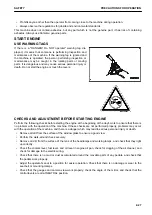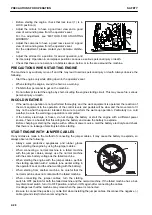
PRECAUTIONS FOR OPERATION
PRECAUTIONS FOR JOBSITE
INVESTIGATE AND CONFIRM JOBSITE CONDITIONS
On the jobsite, there are various hidden dangers that may lead to serious personal injury or death. Before start-
ing operations, always check the following to confirm that there is no danger on the jobsite.
• Always be careful when performing operations near materials such as thatched houses, dry leaves or dry
grass, because they are easily combustible and may cause fire.
• Check the terrain and condition of the ground at the jobsite, and determine the safest method of operation.
Do not operate in a dangerous area where landslides or rockfall may occur.
• If water lines, gas lines, or high-voltage electrical lines may
be buried under the jobsite, contact the management com-
pany to identify their locations, and be careful not to dam-
age any of these lines.
• Take necessary measures to prohibit other personnel from
coming close to the machine during operation.
• In particular, if you need to operate on a road, protect pe-
destrian and cars by designating a person for jobsite traffic
duty or by installing fences around the jobsite.
• When travelling or operating in shallow water or on soft
ground, check the water depth, speed of the current, con-
dition of bedrock, and shape of the ground beforehand. Always avoid any place that will obstruct travel.
PRECAUTIONS WHEN WORKING ON LOOSE GROUND
• Avoid driving or operating the machine near the edge of cliffs, road edges, and deep ditches. The ground
may be weak in such areas. If the ground should collapse under the weight or vibration of the machine,
there is a hazard that the machine may fall or tip over. Remember that the soil is weak in these areas, after
heavy rain or blasting or after earthquakes.
• When working on embankments or near excavated ditches, there is a hazard that the weight and vibration
of the machine will cause the soil to collapse. Before starting operations, take steps to ensure that the
ground is safe and to prevent the machine from rolling over or falling.
DO NOT GO CLOSE TO HIGH-VOLTAGE CABLES
Do not travel or operate the machine near electric cables. There is a hazard of electric shock, which may cause
serious personal injury or death. On jobsites where the machine may go close to electric cables, always observe
the following.
• Before starting work near electric cables, inform the local
power company of the work to be performed, and ask
them to take the necessary action.
• Even going close to high-voltage cables can cause electric
shock. Always maintain a safe distance (see the table) be-
tween the machine and the electric cable. Check with the
local power company about the voltage of cables and safe
operating procedure before starting operations.
Voltage of Cables
Safety Distance
100 V, 200 V
Min. 2 m
6600 V
Min. 2 m
22000 V
Min. 3 m
66000 V
Min. 4 m
154000 V
Min. 5 m
SAFETY
PRECAUTIONS FOR OPERATION
2-25
Содержание PC210-11
Страница 2: ......
Страница 24: ......
Страница 74: ......
Страница 75: ...OPERATION Please read and make sure that you understand the SAFETY section before reading this section 3 1 ...
Страница 352: ......
Страница 353: ...MAINTENANCE Please read and make sure that you understand the SAFETY section before reading this section 4 1 ...
Страница 431: ...SPECIFICATIONS 5 1 ...
Страница 435: ...PC210LC 11 PC210NLC 11 SPECIFICATIONS SPECIFICATIONS 5 5 ...
Страница 436: ...PC230NHD 11 SPECIFICATIONS SPECIFICATIONS 5 6 ...
Страница 458: ...PC210 11 2 Piece Boom PC210LC 11 2 Piece Boom PC210NLC 11 2 Piece Boom 2 PIECE BOOM ATTACHMENTS AND OPTIONS 6 22 ...
Страница 459: ...PC230NHD 11 2 Piece Boom ATTACHMENTS AND OPTIONS 2 PIECE BOOM 6 23 ...
Страница 470: ... Not including tail swing SUPER LONG FRONT BOOM AND ARM ATTACHMENTS AND OPTIONS 6 34 ...
Страница 505: ...REPLACEMENT PARTS 7 1 ...
Страница 521: ......




































